You may have heard the saying “If it’s not grown, it’s mined.” It’s as true for construction materials as it is for anything. The challenge for architects as climate crisis accelerates is to shift the materials palette away from inputs that are extracted from the earth and toward the ones that regenerate.
While the supply of extracted material is finite, biogenic material is inherently—and in some cases rapidly—renewable. Because extracted substances require significant amounts of energy to get them out of the ground and turn them into such familiar forms as steel, concrete, and rigid-foam insulation, biogenic substances typically entail lower levels of energy to make into building products. What’s more, the atmospheric carbon that plant-derived materials such as wood, cork, hemp, and straw sequester during their growth can even exceed the carbon emissions their processing generates, making them net carbon sinks.
So on two major counts—renewability and embodied carbon—stuff that grows can play a vital role in the building sector’s climate-crisis response. And, besides saving the world, architects exploring the use of innovative bio-based materials are finding that they have some significant implications for practice.
“Form follows life cycle,” is how Matthew Barnett Howland, director of research and development with UK-based CSK Architects, sums up the design philosophy emerging from his pioneering work with cork blocks. Design ing, building, operating, and maintaining—and, eventually, disassembling—a building for responsible reuse is a process that could extend over hundreds of years (longer if the time to generate the materials and to break them down again are counted in). “Are there legible connections that can be made between what a building is, as a time-based process, and how it looks and feels as architecture?”
That’s the question to which Cork House, a RIBA Stirling Prize–shortlisted residence in Eton, west of London, responds. Howland designed the project in collaboration with Dido Milne, also a director with CSK, and Oliver Wilton, director of technology at the Bartlett School of Architecture. The world’s first structural-cork house, the 473-square-foot building consists of five linked volumes, each topped with a distinctive pyramid roof. Exemplifying “form follows life-cycle,” the project didn’t set out with a pyramid parti and then figure out how to execute it as sustainably as possible. Rather, the corbeled roof form “sort of designed itself,” says Howland, from a series of matrices of rules-based decisions in relation to sourcing, fabrication, and even eventual disassembly.
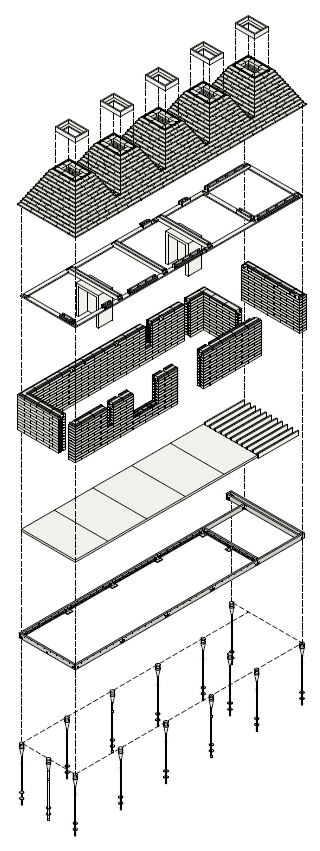
Cork House - Exploded Axonometric Diagram, Image courtesy CSK Architects, click to enlarge.
The construction system consists of cork blocks made purely of heat-expanded and -bonded granules from the bark of the cork oak tree. The species, native to the Mediterranean region, and not to be confused with North America’s endangered white or stave oak, can have its bark removed without damaging the tree. The bark then regrows, so that a single tree can be harvested more than 15 times over its 200-year-plus lifespan. Ancillary structural elements, such as lintels and a ring beam to take lateral roof loads, are built in acetylated wood1 (softwood that’s been hardened in a process that essentially pickles it in a kind of vinegar). Cedar weatherboards clad sloped surfaces on the roof blocks to prevent water from seeping between the horizontal blocks’ granules.
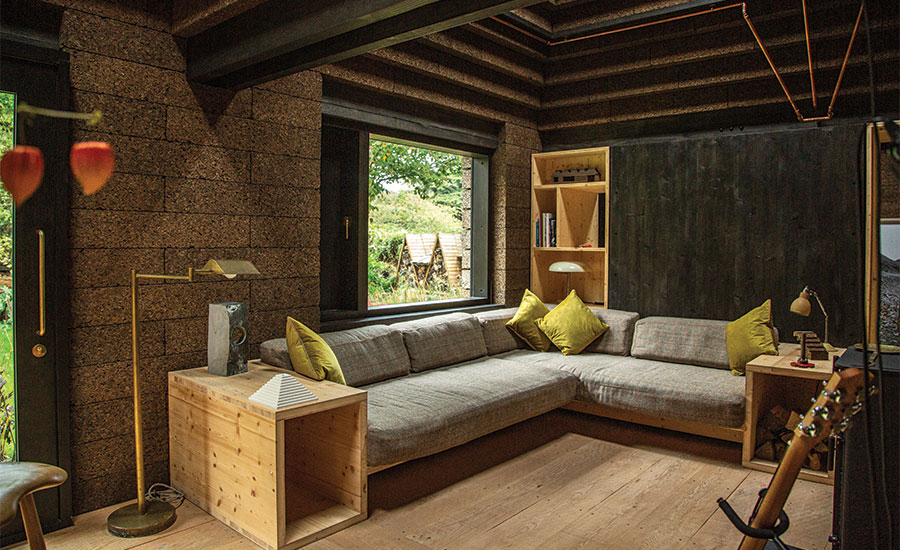
1
The structure, weather envelope, insulation, and interior finish (1) of the Cork House consist almost entirely of cork blocks (2) that are tongue-and-groove friction-fit together. Photo 1 © Magnus Dennis, Photo 2 courtesy CSK Architects
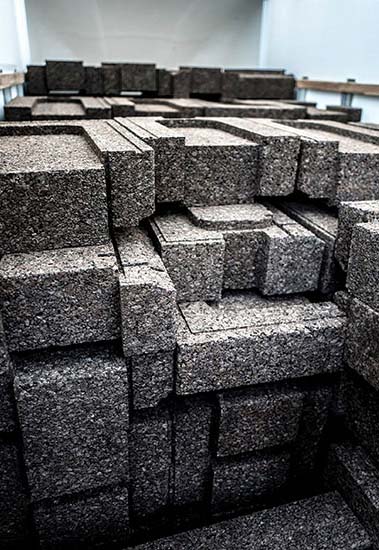
2
The blocks were developed by the design team in collaboration with researchers at the Bartlett, University of Bath, and cork-product manufacturers Armorim UK and Ty-Mawr. Deriving from the architects’ longstanding dissatisfaction with the life-cycle complexity of contemporary building materials, the blocks provide all-in-one structure, weather envelope for vertical surfaces, insulation, and interior finish. They are site-assembled by hand, with a tongue-and-groove friction fit that requires neither fasteners nor glue, and are designed for disassembly and reuse at the end of the building’s life.
Having socked away more atmospheric carbon than its construction entailed, the house was carbon negative at its completion in 2019. Its whole-life emissions are estimated at an extraordinarily low 618 kilograms of carbon dioxide equivalent per square meter (kgCO2e/m2). That figure includes 286 kgCO2e/m2 in embodied carbon (because the standard used for the assessment doesn’t account for carbon sequestration) and 332 kgCO2e/m2 in operational carbon, based on the standard’s assumption of a 60-year lifespan. The emissions, which include end-of-life, are the lowest the project’s third-party assessor has evaluated to date. “Embodied carbon was a particular focus for this project,” says Howland. “Because this reduction in CO2 is delivered at the start of the building’s life, it helps contribute to urgently needed carbon reductions now.”
A factor limiting the widespread adoption of cork at this point is its structural capacity. It’s a bit squidgy, so the load-bearing blocks will compress over the first year or so of the building’s life. The next building in this ongoing investigation will incorporate slightly more wood, expanding the utility and market potential of cork to include multistory construction. But for Howland, the project’s thesis isn’t simply cork. It’s the architectural response to life-cycle considerations behind material resources, fabrication, disassembly, and “how those considerations manifest themselves in the actual architectural thing.”
Another building making that question central is Ashen Cabin, designed by Leslie Lok and Sasa Zivkovic, researchers at Cornell University’s Department of Architecture and co-principals at Ithaca-based HANNAH Architecture and Design. But instead of cork, this building, completed last year in upstate New York, expresses the properties of an innovative material developed in response to the catastrophe now overtaking North America’s ash trees.
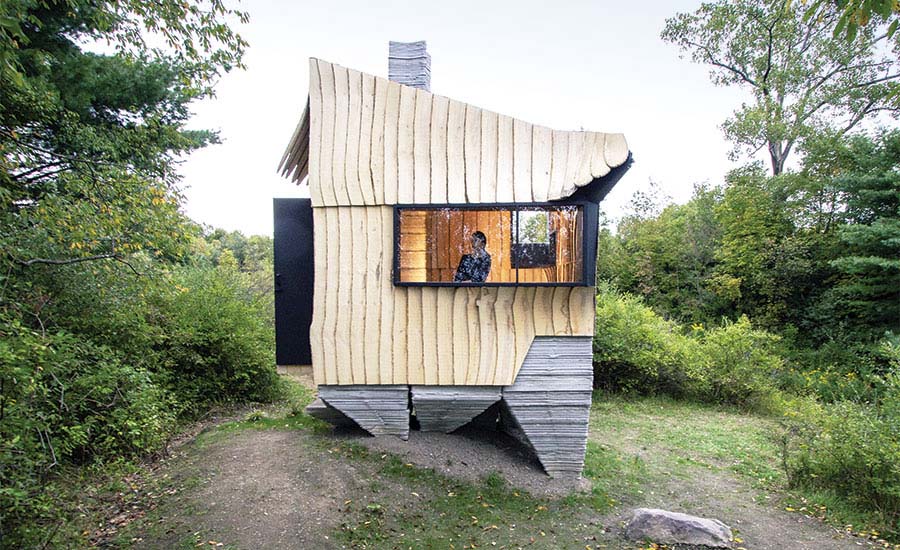
3
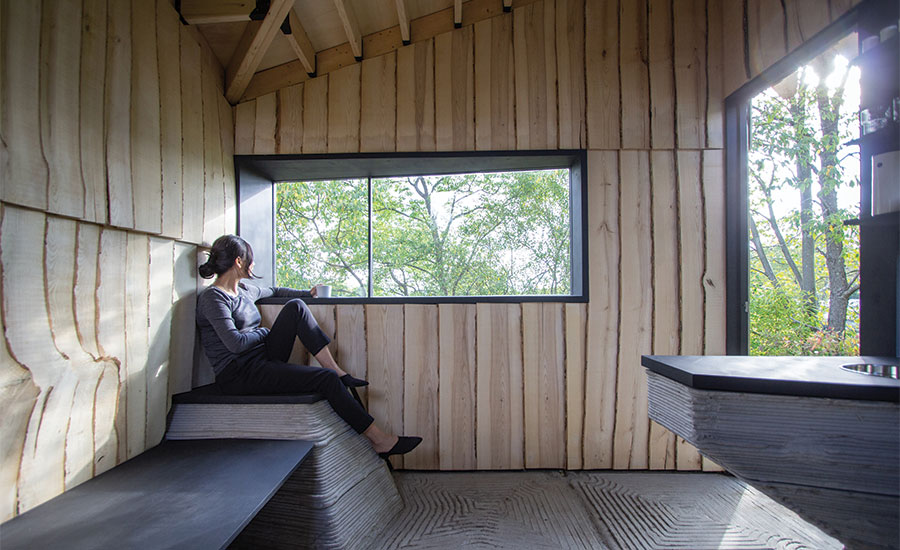
4
3-D LASER SCANNING and robotics-based manufacturing techniques helped HANNAH Architecture and Design create the 100-square-foot Ashen Cabin (3 & 4) in upstate New York from trees killed by the emerald ash borer. Photos © Andy Chen
Casualties of global connectivity, most of the continent’s 8.7 billion ash trees are expected to succumb in the next 50 years to the invasive emerald ash borer. Tens of millions of trees have already been killed, and, unlike the beetle-killed pine forests that went before, the irregular geometries typical of ash defy regular sawmills. To prevent all that wood’s going to waste—and, in the process, releasing its sequestered carbon to an overloaded atmosphere—Lok and Zivkovic have developed a process that applies contemporary technologies to transform the irregular logs into an affordable and distinctive building material. “Looking at this ash tree as a resource reminds us that, as designers, we’re often limited by the standard materials offered by the building industry,” says Lok. “This biomaterial is an opportunity for us to find how to use an enormous alternative resource in a meaningful way.”
The process she and Zivkovic have developed deploys 3-D laser scanning and robotics-based fabrication techniques (basically, a programmable band saw) to cut irregular logs into naturally curving boards of desired thicknesses. The boards are then assembled with a biodegradable closed-cell foam to form structural insulated panels (SIPs).
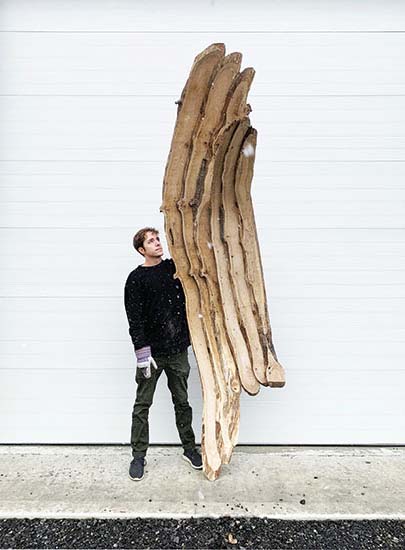
The wood components of Ashen Cabin have been designed to take advantage of the irregular geometries typical of ash trees, including forks and bends. Photo courtesy HANNAH
Ashen Cabin, the 100-square-foot prototype, consists of an ash SIP superstructure on a 3-D-printed concrete foundation. (3-D printing allows the design to minimize the amount of high-embodied-energy concrete.) The cabin comprises three programmatic areas: a table, a storage-seat element, and a 21-foot-tall fireplace. As a building rather than an installation, the project is intended to demonstrate the material’s ability to provide a ventilated, waterproof, and structural envelope.
The designers developed the initial scheme around a set of ash trees’ typical irregularities—for example, forks and bends—organizing these features to highlight such architectural moments as windows, downspout, and door. The project’s crew then headed out into the forest, selected and scanned their lumber, and the designers refined the scheme in response to the specific potential of the chosen wood. “It’s very different from the conventional method of making a design that you give to the contractor, who then builds what you drew,” says Lok. “There is a reciprocity between the design intent and what the raw material can offer.”
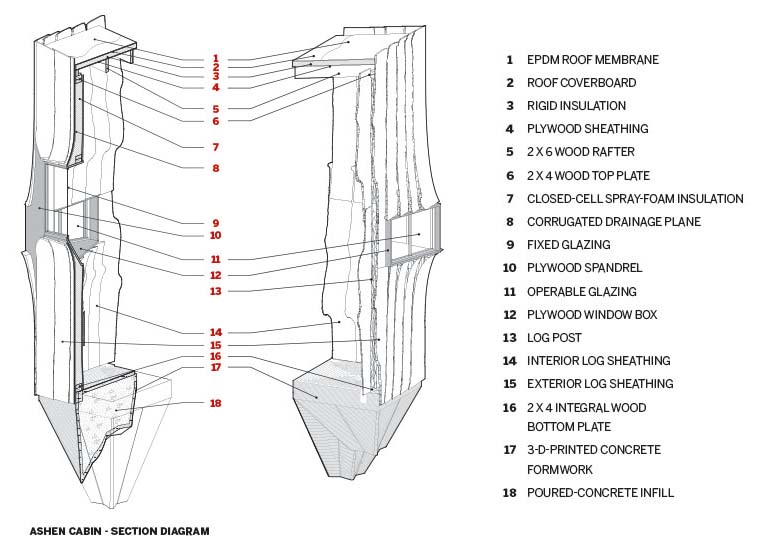
Image courtesy CSK Architects
A process that responds to the uniqueness of organic, found materials might seem to have limited application to the massive scale of both the ash borer catastrophe and the contemporary construction industry. But the integration of laser scanning, robotic milling, and more advanced computational protocols make it conceivable to inventory and digitize an entire forest, says Zivkovic, so architects can know exactly what kind of tree is available to them. “We can actually mass customize,” he says.
It’s also an option to adapt the fabrication method to produce conventional materials, such as glulam, cross-laminated timber, and laminated-veneer lumber. The sheer quantity of dying ash would justify these more standardized uses, but Lok and Zivkovic hope for a middle ground, where the unique characteristics of the material remain legible. “Rather than processing a tree into a standardized material that then gets customized again through design,” they say, “we’re interested in how the idiosyncrasies of the material push for a new architectural expression.”
Ashen Cabin by HANNAH Design Office, Video courtesy HANNAH
While bio-based products such as cork blocks and robotics-enabled ash panels have significant, perhaps revolutionary, implications for architectural expression, others are ready to substitute directly for conventional counterparts. For example, a four-year research project sponsored by the European Union’s Horizon 2020 program, called ISOBIO, concluded in 2019 with the launch of three new low-impact alternatives for common building products.
They include an insulation board, consisting of hemp and a bio-based binder; an insulating lime stucco that uses a high proportion of hemp shiv (the chopped up, woody core of the plant, also known as shives or hurds) as its aggregate; and an insulating and fire-protective clay plaster (incorporating hemp powder) with enhanced moisture-buffering properties. In addition to their stand-alone functionality, these innovative materials have been combined into a composite panel that can be used either as a building envelope in new construction or as an external or internal retrofit. The embodied emissions of the structural panel, at 27.5 kgCO2e/m2, amount to about a quarter of those of a standard new exterior wall; taking into account the atmospheric carbon stored in the panel’s biogenic material would make it carbon-negative.
A related product, hempcrete, is a biocomposite of hemp shiv mixed with a lime-based binder and water. It can be either poured or cast into blocks to form an insulative, non-structural wall. In the United States, since the Industrial Hemp Farming Act of 2018 removed the eponymous plant from the list of controlled substances, hopes for reliable, commercial-scale production of hempcrete are growing.
Meanwhile, a recently completed facility2 in California is expected to begin using rice straw to manufacture medium density fiberboard (MDF) later this year. Rice straw–based MDF upcycles an abundant agricultural waste material, the stems and leaves left behind when the grain is harvested, previously disposed of by burning, and now commonly flooded to speed decomposition. According to the manufacturer, rice straw is in some ways even better suited to MDF than wood: its curling shape and natural waxes make for a stronger panel with better moisture resistance, and it certainly grows faster.
While there’s excitement around the prospect of bio-based alternatives for such common components as insulation board and MDF, the availability of substitutes for structural and envelope components—often among a building’s highest embodied-carbon materials—remains limited. “There’s a world of advancement right now in products like carpet and furnishings,” says Christiana Moss, a principal at Phoenix-based Studio Ma. “We’d like to see that level of innovation in primary architectural materials.”
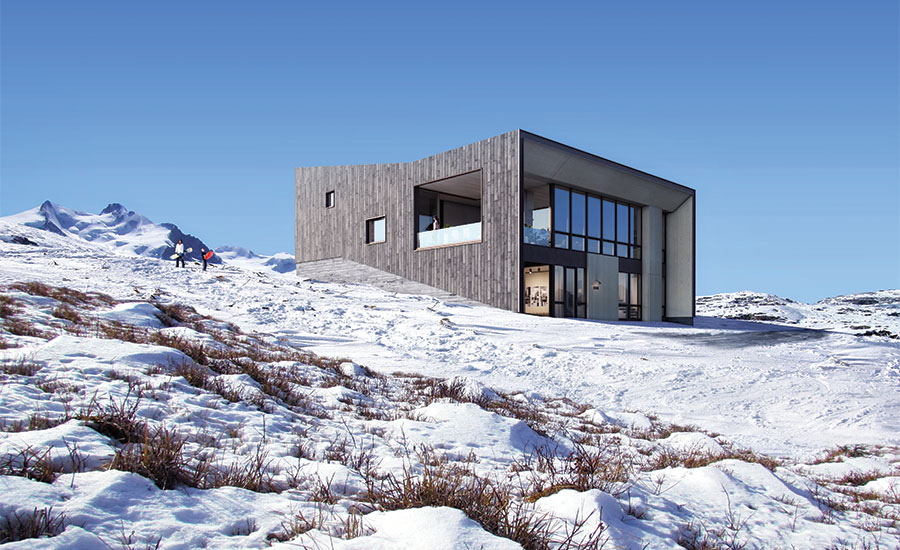
Studio Ma House. Image courtesy Studio Ma
Studio Ma has been tracking carbon in its projects since 2010, when the firm conducted a full embodied-carbon study. “Learning about how much embodied carbon already exists in the built environment was eye-opening,” says Moss. To curtail its projects’ contributions, the firm’s design approach seeks first to maximize the use of a development’s given conditions, to evaluate and then minimize additional requirements, and to meet remaining needs as much as possible with materials that are renewable. Examples of products the firm has used include plant-based ceiling tiles and cork-and-linseed-based resilient flooring; products it is monitoring for opportunities include the ISOBIO panels, mycelium composites (using the filament network of fungi), and denim- and wool-based duct liners.
For a 1,500-square-foot house now starting construction in Eden, Utah, Studio Ma designed a rainscreen envelope using an innovative bio-based cladding. Because the project’s mountainside site provides views of the two-story house from above, the cladding will even be used on the roof. The building will be wrapped in a sustainably sourced softwood that has been impregnated with furfuryl alcohol, a nontoxic waste product of agricultural crops such as sugarcane and corn. Developed in Norway, the toxin-free treatment thickens the cell walls of the softwood, rendering it hard, dimensionally stable, rot-resistant, and low-maintenance3.
Located at an elevation of 9,000 feet, the house will be exposed to sun, wind, snow, and a daily freeze-thaw cycle that lasts from November to May. In these harsh conditions, the maintenance requirements typically associated with wood might well have trumped its ability to store atmospheric carbon at about 50 percent of its dry weight, and led the house’s owners to prefer a higher-carbon option. But for a price and expected lifespan comparable to metal cladding, says Moss, “the fact that we have a 30-year-warrantied facade from this material is a game-changer.”
That’s a term that could apply equally well to an expanding, but still regrettably limited, range of bio-based building products. The houses profiled here demonstrate the carbon-saving potential of some of them. The projects also invite consideration of the role and tectonics of environmentally innovative materials and methods in contemporary practice. These alternatives offer, as Howland says, “more of a medium through which to explore a broader architectural idea.” Whether that’s to do with simplicity of materials and construction, authenticity of expression, or the nature of an environmentally aligned practice, the bio-based materials now emerging onto the market offer a strong place to start.
- Accoya
- CalPlant
- Kebony
Continuing Education

To earn one AIA learning unit (LU), including one hour of health, safety, and welfare (HSW) credit, read “Continuing Education: Bio-Based Materials” and the following:
Then complete the quiz. Upon passing the test, you will receive a certificate of completion, and your credit will be automatically reported to the AIA. Additional information regarding credit-reporting and continuing-education requirements can be found at continuingeducation.bnpmedia.com.
Learning Objectives
- Explain why bio-based materials typically have lower embodied carbon than conventional materials.
- Describe ways that materials normally thought of as waste are being used in construction.
- Discuss processes and technologies that can extend the lifespan of some bio-based materials.
- For the three houses covered in this article, discuss the relationship between their use of environmentally innovative materials and their architectural expression.
AIA/CES Course #K2006A


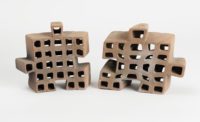
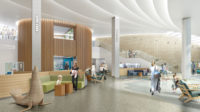
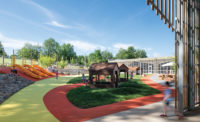
Post a comment to this article
Report Abusive Comment